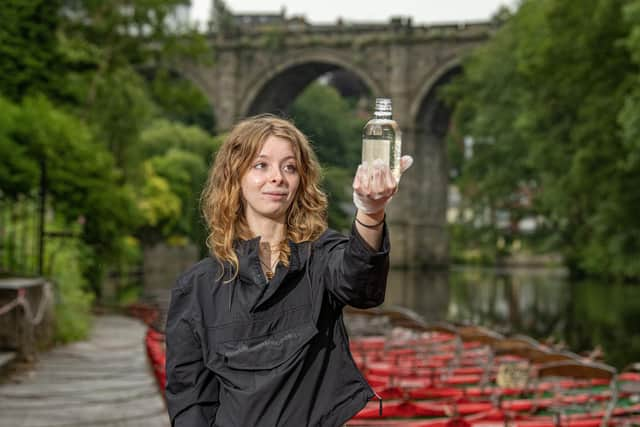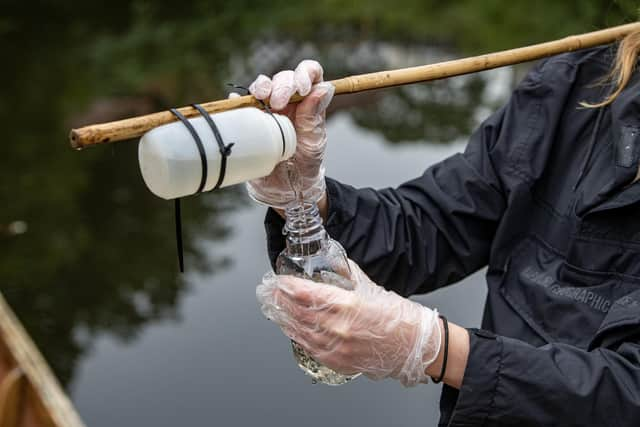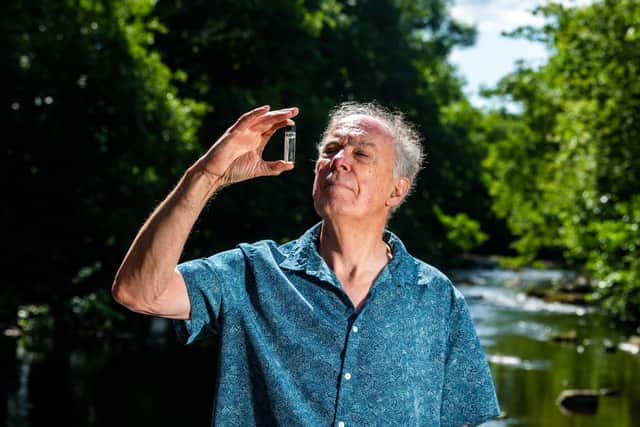Yorkshire sewage dumping: ‘It’s an open sewer. When you look at these banks, they could be so lovely’
So they’ve taken up arms, warrior-like, with a ‘bottle on a stick’ nicknamed Boss. And they sample the river, again and again, gathering proof of the gruesome need for change.
Testing, it seems, is the only spear in their armoury; the only tool they might have, to arm their charge in campaigning for better. And in the end, in the hopes of a cleaner river.
Advertisement
Hide AdAdvertisement
Hide AdTo angler David Clayden, on the banks of the Nidd where the trout fly and a small otter is hiding, this does matter.


“It’s so beautiful,” he said. “It’s an open sewer, in some way or another. When you look at these banks, they could be so lovely. But that milky colour...
“We’ve got to fight for our rivers. It’s important.”
Mr Clayden is chair of the The Nidd Action Group (NAG), which is seeking bathing water status at Knaresborough. Success, were it to come, would put pressure on Yorkshire Water to invest in cleaning up the whole course of the waterway.
It began, as many of the nation’s Clean Rivers campaigns have, in Ilkley. Campaigners here were the first in the country to secure such protection for the Wharfe, with all the monitoring and promises of money. And they’ve been generous in lending expertise.


Advertisement
Hide AdAdvertisement
Hide AdMr Clayden, secretary of the Harrogate Flyfishing Club, was walking the Nidd’s banks at Darley when he first noticed a foul smell. There was a sewage works, letting out waste.
“I took photographs, I reported it. I kept reporting it, every time,” he said. “Nothing happened. In the end, I’ve learned the longitude and latitude, it’s happened so often.
“The storm overflow, well it overflows, and not when it’s raining.”
The fishing clubs of North Yorkshire, with guidance from Ilkley, started testing the water in 2021. Sure enough, said Mr Clayden, there was a high level of E-coli at Darley.


Advertisement
Hide AdAdvertisement
Hide AdThere was a parish meeting. Then a second, and a third. Suddenly, the fly-fishers were in the minority. There were swimmers, paddle boarders, dog walkers, and environmentalists. MP Andrew Jones is leading the charge, with his team testing at Knaresborough Lido.
Downriver from Darley, beneath the bridge of the world-famous viaduct, Maddy Wright is dipping the waters.
Tentatively, she leans over to scoop up a sample of the river water. She’s not allowed to step in.
It’s now officially bathing water season, from mid May to September. The MSc student, from the University of Leeds, carries with her a tool box of hi-tech equipment.
Advertisement
Hide AdAdvertisement
Hide AdSince February, there have been regular tests. It sounds a bit overwhelming, but she is confident in the science.
There are 10 sites to sample, around combined sewer overflows (CSOs). If it is hot, samples go on ice before being sent to a lab.
“There’s a big perception that pollution in the river comes from the CSOs,” she said. “That does happen. But it’s hard to say how much. They should be discharging only in extreme weather. And the water companies measure the time it goes for – not what’s in it.”
If and when bathing water status is granted, then official monitoring will begin. But there will always be a time lag.
Advertisement
Hide AdAdvertisement
Hide Ad“I just want to help,” she said. “It gives us some general information. There’s always recreational users for the river, and this highlights some of the risks.”
The Nidd is popular with swimmers. Paddleboarders at Conyngham Hall. Dogs splash along its length. Every summer, families ask what’s in the water. It is rated as ‘moderate’, even in the tourism hotspots within the Nidderdale AONB.
It’s too early to analyse data. So far, there have not been any major red flags. The only problematic data so far appears to be the E-coli.
James McKay, Maddie’s coordinator at the University of Leeds, plays a key role in linking the campaigning with the research and science.
Advertisement
Hide AdAdvertisement
Hide AdHe also lives in Knaresborough. He swims in the river almost every day. It’s “crucial”, he said, to people, but also to wildlife and to the area’s ecosystem.
If the “central element” of the valley is the river that runs through it, then it sustains the life surrounding it, he said. But Mr McKay believes the River Nidd is low on the priority list. Solutions, to the bigger battle, are complicated. There are “lots of shades of grey”.
“There’s good people in Yorkshire Water, who are doing their level best to make a difficult situation better,” he reflected. “What seems weird to me is there’s no public investment.”
But both agree a longer-term vision is needed.
“We can’t keep on putting in bigger pipes indefinitely,” added Mr McKay. “The system is overwhelmed.”
Advertisement
Hide AdAdvertisement
Hide AdFor now, bids are underway, to be submitted in September. If successful, official monitoring will begin.
“The bathing water status is the only avenue that we have,” admitted Mr McKay. “To put pressure on the water company to clean up the river.”
NAG is counting wild swimmers. Charitable funding has been secured, but they need more. Trained teams are getting ready for a big test, at 45 sites, all on one day to builds a snapshot that cannot be discounted.
“There’s lots of modelling but precious little data,” he said. “So we are going to provide it. We have a lack of confidence, that they know all these thousands of miles of pipes and all the bad spots. I don’t have the confidence they know what’s going on.”
Advertisement
Hide AdAdvertisement
Hide AdRegular monitoring of the rivers has been replaced by reactive sampling and only when alerted by the public, he claims.
“They don’t measure E-coli. Defra, that used to, don’t do it now. They are clearly shifting towards citizen science. Now, it’s become responsive.”
There is no ‘one single solution’, he sighed. Ultimately, the rivers must be better.
“It’s got to work, to do something – even if it might not match up in ‘cost benefit’ terms. Rivers should be clean. That’s what democracy is all about. And then we invest accordingly.”
Advertisement
Hide AdAdvertisement
Hide AdA Yorkshire Water spokesman said: “Tackling overflows, which were designed into the system as a relief valve, is a priority for us, but it is also a significant task. In Yorkshire, we have over 2,200 overflows and we know replumbing the whole of Yorkshire is not a quick fix as it would be both significantly disruptive and costly to customers.
“But, we are investing £180m in storm overflow improvements in the next two years – above and beyond our existing business plans – which includes work on three overflows on the Nidd and its tributaries at Pateley Bridge, Dacre Banks and Birstwith.
“We are already planning our largest ever environmental investment for the five years between 2025 and 2030 and our draft plans, which require review and approval by Ofwat, outline 19 overflows that will be improved on the Nidd and its tributaries.”